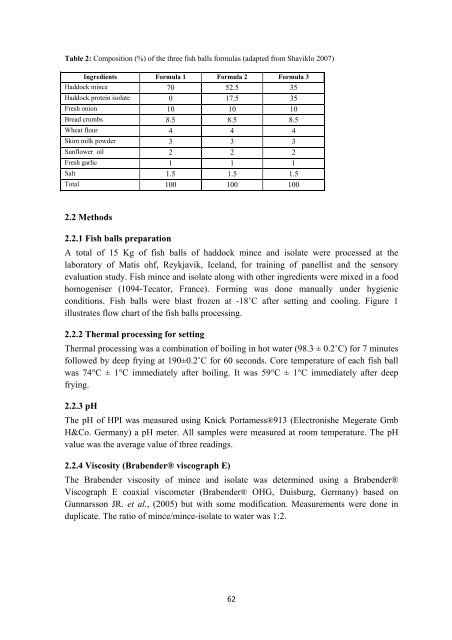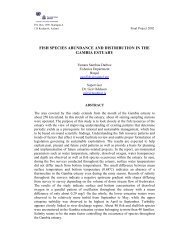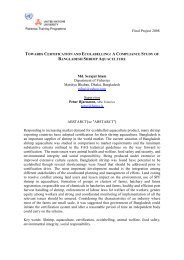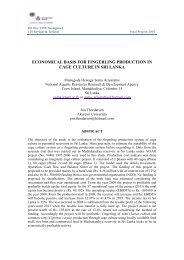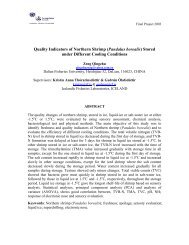Evaluation and Utilisation of Fish Protein Isolate Products
Evaluation and Utilisation of Fish Protein Isolate Products
Evaluation and Utilisation of Fish Protein Isolate Products
- No tags were found...
You also want an ePaper? Increase the reach of your titles
YUMPU automatically turns print PDFs into web optimized ePapers that Google loves.
Table 2: Composition (%) <strong>of</strong> the three fish balls formulas (adapted from Shaviklo 2007)Ingredients Formula 1 Formula 2 Formula 3Haddock mince 70 52.5 35Haddock protein isolate 0 17.5 35Fresh onion 10 10 10Bread crumbs 8.5 8.5 8.5Wheat flour 4 4 4Skim milk powder 3 3 3Sunflower oil 2 2 2Fresh garlic 1 1 1Salt 1.5 1.5 1.5Total 100 100 1002.2 Methods2.2.1 <strong>Fish</strong> balls preparationA total <strong>of</strong> 15 Kg <strong>of</strong> fish balls <strong>of</strong> haddock mince <strong>and</strong> isolate were processed at thelaboratory <strong>of</strong> Matis ohf, Reykjavik, Icel<strong>and</strong>, for training <strong>of</strong> panellist <strong>and</strong> the sensoryevaluation study. <strong>Fish</strong> mince <strong>and</strong> isolate along with other ingredients were mixed in a foodhomogeniser (1094-Tecator, France). Forming was done manually under hygienicconditions. <strong>Fish</strong> balls were blast frozen at -18˚C after setting <strong>and</strong> cooling. Figure 1illustrates flow chart <strong>of</strong> the fish balls processing.2.2.2 Thermal processing for settingThermal processing was a combination <strong>of</strong> boiling in hot water (98.3 ± 0.2˚C) for 7 minutesfollowed by deep frying at 190±0.2˚C for 60 seconds. Core temperature <strong>of</strong> each fish ballwas 74°C ± 1°C immediately after boiling. It was 59°C ± 1°C immediately after deepfrying.2.2.3 pHThe pH <strong>of</strong> HPI was measured using Knick Portamess®913 (Electronishe Megerate GmbH&Co. Germany) a pH meter. All samples were measured at room temperature. The pHvalue was the average value <strong>of</strong> three readings.2.2.4 Viscosity (Brabender® viscograph E)The Brabender viscosity <strong>of</strong> mince <strong>and</strong> isolate was determined using a Brabender®Viscograph E coaxial viscometer (Brabender® OHG, Duisburg, Germany) based onGunnarsson JR. et al., (2005) but with some modification. Measurements were done induplicate. The ratio <strong>of</strong> mince/mince-isolate to water was 1:2.62


